World’s largest mammal that ever walked the face of the earth used to live in Pakistan’s Balochistan province. Yes it is true.
 This mammal is called Baluchitherium (The Beast of Balochistan). So far the fossils of this mammal have only been found in Baluchistan and Central Asia.
This mammal is called Baluchitherium (The Beast of Balochistan). So far the fossils of this mammal have only been found in Baluchistan and Central Asia.
In 1999, a team of French Palaentologists discovered the complete skeleton of this giant mammal in Dera Bugti Hills of Pakistan. The find came as the result of a 5 month long expedition by the French Team in the Balochistan desert.
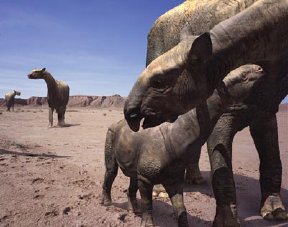 All in all it was a 5 year long on-and-off study. The French team was led by Professor Jean-Loup Welcomme of the Natural History Museum in Paris. While the first complete skeleton of Baluchitherium was dicscovered in 1999, it was as early as 1846 when first pieces of fossilized Baluchitherium were accidentally stumbled upon in Dera Bugti by a British Army officer who went by the name of Vickary.
All in all it was a 5 year long on-and-off study. The French team was led by Professor Jean-Loup Welcomme of the Natural History Museum in Paris. While the first complete skeleton of Baluchitherium was dicscovered in 1999, it was as early as 1846 when first pieces of fossilized Baluchitherium were accidentally stumbled upon in Dera Bugti by a British Army officer who went by the name of Vickary.
In 1909 another skeleton was found in the same area by a British team led by Mr. Forster-Cooper of the Cambridge Sedgwick Museum.
Following photo is a replica of Baluchitherium created for a museum in western hemisphere.
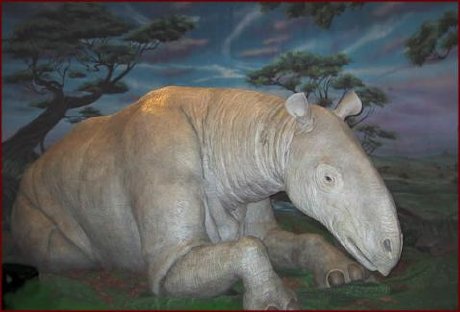
According to a BBC news report of May 10, 1999:
Baluchitherium is an extinct rhinoceros that lived during the Tertiary Period about 20 to 30 million years ago. With its long neck and legs, it was thought to feed high up in the trees. However, unlike the modern rhinoceros, the animal had no horn.
It had an estimated shoulder height of nearly 18 ft (5.5 m), a length of upto 28 feet (from nose to rump) and a weight of about 10 to 15 tons. The head was four feet long, sitting on top of a six feet long neck. This beast had poor eyesight, but made up for this with keen hearing and smell. Baluchitherium is classified in the phylum Chordata, subphylum Vertebrata, class Mammalia, order Perissodactyla, family Rhinocerotidae.
Following photo shows the French team and their Pakistani helpers recreating the skeleton of a Baluchitherium
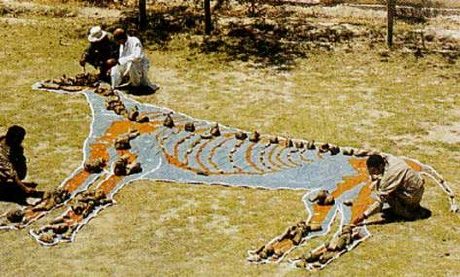
BBC News report further says that:
Although fossil remains of Baluchitherium have been discovered before, a near-complete skeleton has always evaded palaeontologists. The fact that the Baluchitherium was able to live in Baluchistan is giving scientists clues about the climate in the area millions of years ago.
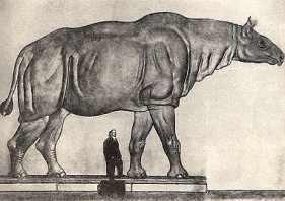 Eventhough Balochistan is now mostly a desert but since Baluchitherium would have needed as much as two tonnes of fodder every day, the French team believes this area of Pakistan must have been heavily forested.
Eventhough Balochistan is now mostly a desert but since Baluchitherium would have needed as much as two tonnes of fodder every day, the French team believes this area of Pakistan must have been heavily forested.
It is said that the Baluchitherium was a very defensive animal, and attacked any animal that was nearby. This beast tried to charge and trample foes with its front feet.
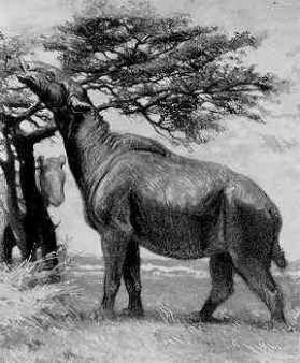 In an article written few years ago at www.thehotspotline.com blogger Ali Khan writes:
In an article written few years ago at www.thehotspotline.com blogger Ali Khan writes:
At a recent function organised by the Pakistan Embassy in Paris which saw the launch of the Pak-France cultural forum, professor Welcomme delivered a lecture on his recent find. He also thanked the Nawab of Bugti, the Bugti people and the University of Balochistan for extending all assistance to the French team. The Nawab of Bugti convinced other tribes to allow the team to work in the area and also provided material and technical assistance to Professor Welcomme‘s team.
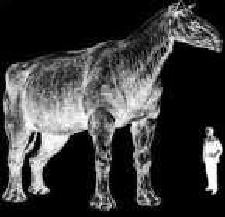 The latest news about Baluchitherium came last week when in early March 2008, more pieces of Baluchitherium have been excavated in Dera Bugti area. I read this update in Jang’s latest news feed but didn’t see the detailed news on it in the regular paper.
The latest news about Baluchitherium came last week when in early March 2008, more pieces of Baluchitherium have been excavated in Dera Bugti area. I read this update in Jang’s latest news feed but didn’t see the detailed news on it in the regular paper.
Is There A Baluchitherium Museum in Pakistan?
The short answer in NO.
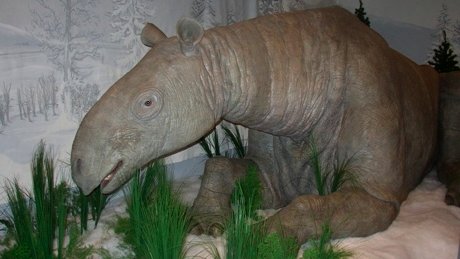
But then I am not familiar either with what has been done at Government level to help finding and preserving Baluchitherium fossils. A National museum displaying some fossils of this mammal who roamed the land of Pakistan before us is the need of the hour. Does any of our readers know about any effort in this regard? If we come to know of any effort, we’ll update this paragraph here with the new information.
Baluchitherium Trivia:
1. Baluchitherium is a Van Halen instrumental from their 10th studio album, Balance (album).
2. Baluchitherium is also the name of a monster appearing in the computer game NetHack.
Photo Credits:
1. 50birds.com
2. biocrawler.com
3. davo.com
4. Major Fossil find in Balochistan by Ali Khan
5. kokorodinosaurs.com
6. dionsoria.com
7. elachee.org
References:
1. Geological Survey of Pakistan
2. Major Fossil find in Balochistan by Ali Khan
3. BBC News Feed of May 10, 1999
4. Enchanted Learning
5. La Baluchitherium




















































Hassan. thanks a lot for updating 1999 find info. i don’t know if 2008 find was new or not. The Jang news that I read couple of weeks ago was something like “palaentologist collected more remains of Baluchitherium from Dera Bugti-Kaahan area and moved them to Quetta”. This was shown as ‘latest news update’ feed but the next day I couldn’t find this news in regular news.
Great post! Just a little update – the 1999 skeloton was not a full skeleton from a single beast. It was just the first full ‘composite skeleton’. That means, one set complete set of all the bones which existed in the beast was found, though it did not necessarily came from one sinlge animal.
I don’t know about the latest find of 2008.
Thanks for a great article!
Our country is literally a paradise of life.
Actually, some readers might not be aware that the region widely known as the “Fossil Paradise” is in the northern part of Pakistan. It is where the largest concentration of echinoderm fossils are found – echinoderms are tough spiny-skinned marine animals like starfish and sea cucumbers. It is used as evidence that the area was once covered by the ocean – the Tethys sea, now known as the Mediterranean.
This article reminds me of the ’80’s, when I was in grad school and was invited by my most respectable zoology professor, Dr. Muhammad Shareef Khan of T. I. College, Rabwah, to join him for a research project in Cholistan desert and Baluchistan. The research would be in partnership with Dr. George R. Zug, a noted American herpetologist and author of Encyclopaedia Britannica’s article on aging. We planned on studying reptiles, on which Dr. Khan is an authority. I was all excited to get an opportunity to work with an American scientist and funded by an American grant. Dr. Khan and I had great conversations with Dr. Zug and were all set to go when the Pakistani Government didn’t issue the American a visa for the 5-year project. At the time we were dismayed at being blocked by such a silly hurdle (they probably thought Zug was a spy), and the project was terminated.
But one lesson we can learn from this is that if the Pakistani government officials could be educated about the richness of our heritage, we might be able to convince them to fund at least native scientists to pursue such projects and bring good name to Pakistan.
If Baluchitherium were studied by Pakistan-funded grants and Pakistani scientists, the French wouldn’t be getting credit for this great find today – just a thought!
All for a museum highlighting Baluchitherium (in Quetta?), and soon!
Wassalam,
Rasheed
@Akbar Das
My comment about Noah’s Arc was merely an invitation for 3 major religions of world (based on Genesis) to think outside the box.
Stephen Hawking in a recent conversation with Charlie Rose emphasised on space exploration.He does not think we can survive on this planet for more than a few centuries.He said human race should not put all its eggs in one basket or one planet let us hope we can avoid dropping the basket before we spread the load.Our greed and stupidity has brought us very close to disaster.
@Daktar
It is thought that birds and reptiles evolved from Dinosaurs and other mammals like apes,elephents,horses and rhinos from Baluchitherium also known as Indricotherium
History 101:
Modern human beings or ‘Homo Sapiens’ originated in Africa about 200,000 years ago. Baluchitherium, as stated above, lived about 20 to 30 million years ago. Hence dear friends, Noah and his Arc had nothing to do with Baluchitherium.
And yes, super article.